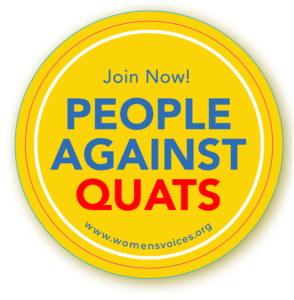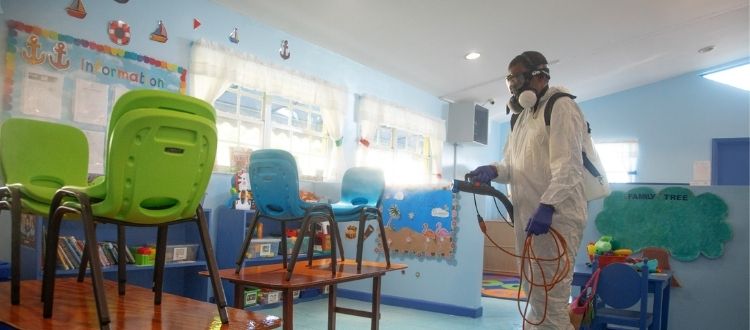6 Reasons Why Disinfectant Foggers, Misters, Electrostatic Sprayers Are Not the Answer to Safer Spaces
Download a pdf of this fact sheet – click here.
 |
| Alex Scranton Director of Science and Research |
Disinfectant foggers, misters and electrostatic sprayers: These machines – often costing thousands of dollars – promise to coat all the surfaces in a room with an effective disinfectant spray that will kill COVID and other microbes in a matter of minutes, with very little effort. Some companies even claim the disinfectant protection lasts for hours or days after spraying once. It’s no surprise that marketing claims like this are popular and welcomed, especially by overworked, understaffed cleaning staff – who have been given an extra mandate during the pandemic to make sure everything gets disinfected multiple times a day. But unfortunately, these products are simply providing more risk than benefit.
But here’s what we know about these products.
1. Many disinfectants made for use with electrostatic sprayers and misters contain quats.
Note: Active ingredients listed for quat-containing products will look like (or similar to)
Alkyl (60% C14, 30% C16, 5% C12, 5% C18) dimethyl benzyl ammonium chlorides
Alkyl (68% C12, 32% C14) dimethyl ethylbenzyl ammonium chlorides
We are concerned about exposure to quats because they can irritate your lungs leading to breathing problems and are linked to reproductive harm. It is unclear what additional health concerns are created by misting or spraying these chemicals (which are, in fact, anti-microbial pesticides) roomwide.
2. To disinfect effectively, all surfaces must be pre-cleaned of dirt first.
Pathogens like viruses can survive well in dirt, soil and goo found on surfaces that are frequently touched. And when well-hidden in that goo, these bacteria and viruses can easily survive an application of disinfectant. The marketing of electrostatic sprayers commonly emphasizes the ease and timesaving nature of these devices – but neglects to mention that they won’t actually disinfect if you haven’t taken the time and effort to manually clean all the surfaces first. And the additional health benefit of disinfecting after you have already thoroughly cleaned a surface has not been thoroughly examined and is a matter of debate.
3. We don’t know how long disinfectant particles emitted from electrostatic sprayers stay in the air after spraying.
While there are very clear recommendations for users to avoid inhaling any spray from electrostatic sprayers, there are no published studies documenting how long particles will stay in the air after spraying.[1] Many companies claim that a room that has been sprayed can be entered safely by others immediately after spraying, but without the data, we really don’t know how safe or harmful that exposure is to our health.
4. Neither the U.S. Centers for Disease Control (CDC) nor the World Health Organization (WHO) support the use of electrostatic sprayers for disinfection.
The CDC’s Guidelines for healthcare facilities specifically state “Do not perform disinfectant fogging in patient-care areas.” These guidelines are based on an absence of evidence that this type of disinfection is effective, and out of concern for potential adverse health effects on healthcare workers.[2] If the CDC doesn’t find these disinfecting sprayers appropriate for healthcare facilities, it seems they would be even less useful for other public spaces, where the infection risks are considerably lower. The WHO has published guidelines for cleaning and disinfecting during COVID which specifically states “In indoor spaces, routine application of disinfectants to environmental surfaces by spraying or fogging (also known as fumigation or misting) is not recommended for COVID-19.”[3] Again the concerns are due to lack of evidence that it is effective and the adverse effects of the exposure to the disinfectant spray.
5. The U.S Environmental Protection Agency (EPA) has not approved any products claiming to be effective against COVID for days to months.
While there are a handful of products approved to kill bacteria over a longer time period, there are no products registered to be effective for viruses (like coronavirus) to the same extent. The EPA is conducting some research to find out if this is possible, but no final conclusions have been published, or products approved.[4] In any case, many products making these long term claims currently often include a small-print caveat that states that the disinfection benefits would only last when surfaces are not touched or disturbed after application. (Basically, the products are useless for your frequently-touched high risk surfaces – and relatively pointless for surfaces that no one is coming into contact with anyway.)
6. There are no long-term studies available that have confirmed that the use of electrostatic sprayers to disinfect spaces have effectively reduced illness.
Manufacturers can measure decreases in the amount of bacteria and viruses found on surfaces immediately after spraying – but the proof of efficacy is really whether or not people using those sprayed spaces are getting less sick as a result. For example, numerous schools have implemented electrostatic spraying protocols as a result of terrible flu outbreaks in recent years, but there are no follow-up studies documenting consistently reduced flu absenteeism in subsequent years of use.
Foggers, misters and electrostatic sprayers, despite the many promises they make, are not the solutions we need to protect health and reduce illness — rather they seem to do little more than increase exposure to harmful chemicals. This is especially concerning when considering the growing use of these foggers and misters in public spaces like schools, childcare facilities, offices, churches and apartment buildings – not to mention the short and long-term health impacts on workers who are mandated to apply these products on a daily basis. This is disinfectant-overkill. And it’s a problem.
Protection is important. Cleaning (and even some occasional careful disinfecting) is a good thing to do for our health. But it has to be done with caution, often with gloves and eye protection, always with good ventilation, and with the safest disinfecting chemicals we have available. And keep in mind, as we have learned more about COVID, it appears that the risk of infection from touching contaminated surfaces is a lot lower than we thought – and the significant risk is more likely from the airborne person-to-person transmission.[5] [6] So, prioritize those actions that we know are effective in reducing illness and the spread of COVID-19: get the vaccine, wash our hands, continue to social distance (stay home as much as you can), and wear a mask.
Download a pdf of this fact sheet – click here.
Helpful Resources
Additional resources and references on safer cleaning and disinfecting during the times of COVID-19:
- See WVE’s coronavirus resources page
- Safer Cleaning Practices for the Workplace from MFL Occupational Health Centre (OHC)
- The University of Washington School of Public Health’s fact sheet on safer disinfecting, that emphasizes the need for using soap and water, can be found here.
- From the San Francisco Department of the Environment: Safer COVID-19 cleaning products and disinfectants
- Guidance from the Western States Pediatric Environmental Health Specialty Unit on Safer Disinfectant Use during the COVID-19 Pandemic.
- Op’Ed: Overuse of disinfectants can put schoolchildren at risk
 Want to do more? Join PAQ
Want to do more? Join PAQ
Concerned about the overuse and misuse of disinfectants in your community? Fired up about ensuring safer disinfectants are used in your schools, offices, gym, grocery stores and apartment buildings? Consider joining WVE’s nation action group, PAQ (People Against Quats) today! Click here to learn more.
————————
[1] https://www.publichealthontario.ca/-/media/documents/ncov/ipac/2020/07/faq-covid-19-electrostatic-sprayers.pdf?la=en
[2] https://www.cdc.gov/infectioncontrol/guidelines/environmental/updates.html (See Environmental Fogging [December 2009]
[3] file:///Users/alexs/Downloads/WHO-2019-nCoV-Disinfection-2020.1-eng-1.pdf
[4] https://www.epa.gov/healthresearch/long-lasting-sars-cov-2-disinfection-evaluation-test-results “Therefore, there are currently no EPA-registered products eligible to make claims that they are effective against SARS-CoV-2 over the course of days to months (i.e., “long lasting” efficacy claims).”




These will make the individual exposed more susceptible to Covid not less!
I believe Fogger’s are not the same machines as electrostatic sprayers. Foggers require more PPE because they have a high inhalation risk. CDC specifically mentions foggers, not electrostatic sprayers. I’m not saying ES are completely safe, but it would be incorrect to apply a CDC recommendation to a completely different product with different application method.
https://www.thejanitorialstore.com/public/electrostatic-sprayers-vs-foggers-162.cfm
Thanks so much for your comment. It is true there is a technical distinction between foggers and electrostatic sprayers, with electrostatic sprayers adding an electrical charge which affects how the droplets will cling to surfaces. However, the CDC’s recommendations do cover sprayers as well as foggers. While the CDC titles their recommendation “Environmental Fogging” the text clearly states: “These recommendations refer to the spraying or fogging of chemicals (e.g., formaldehyde, phenol-based agents, or quaternary ammonium compounds) as a way to decontaminate environmental surfaces or disinfect the air in patient rooms.” And electrostatic spraying, although technically unique from fogging, is still considered “spraying chemicals as a way to decontaminate environmental surfaces”. From our point of view, the concerns about both foggers and electrostatic sprayers are the same – they put disinfectant chemicals into the air posing an inhalation hazard – and the marketing of these products frequently misleads users to believe that these products are timesavers which do not require pre-cleaning of surfaces – which could result in surfaces that are still infectious.
Hope that helps clarify.
Thank you for posting about this serious health issue Alex!
Please share the petition below widely.
Stop the use of electrostatic spraying and fogging of toxic chemicals
https://www.change.org/SayNoToToxins